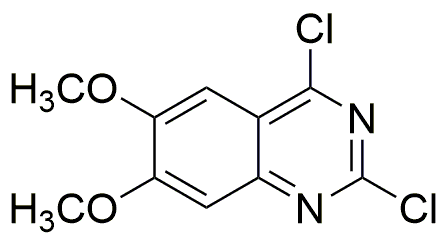2,4-Dichloro-6,7-dimethoxyquinazoline is widely utilized in research focused on:
- Pharmaceutical Development: This compound serves as a key intermediate in the synthesis of various pharmaceuticals, particularly in the development of drugs targeting cancer and other diseases due to its ability to inhibit specific enzymes.
- Agricultural Chemicals: It is used in formulating herbicides and pesticides, providing effective solutions for weed control in crops, thus enhancing agricultural productivity.
- Biochemical Research: Researchers leverage its properties to study biochemical pathways and mechanisms, especially in the context of enzyme inhibition and receptor interactions.
- Material Science: The compound is explored for its potential in creating advanced materials, including polymers and coatings that require specific chemical resistance and stability.
- Analytical Chemistry: It is employed as a standard in analytical methods to ensure accurate detection and quantification of similar compounds in various samples, supporting quality control processes.
Informations générales
Propriétés
Sécurité et réglementation
Applications
2,4-Dichloro-6,7-dimethoxyquinazoline is widely utilized in research focused on:
- Pharmaceutical Development: This compound serves as a key intermediate in the synthesis of various pharmaceuticals, particularly in the development of drugs targeting cancer and other diseases due to its ability to inhibit specific enzymes.
- Agricultural Chemicals: It is used in formulating herbicides and pesticides, providing effective solutions for weed control in crops, thus enhancing agricultural productivity.
- Biochemical Research: Researchers leverage its properties to study biochemical pathways and mechanisms, especially in the context of enzyme inhibition and receptor interactions.
- Material Science: The compound is explored for its potential in creating advanced materials, including polymers and coatings that require specific chemical resistance and stability.
- Analytical Chemistry: It is employed as a standard in analytical methods to ensure accurate detection and quantification of similar compounds in various samples, supporting quality control processes.
Documents
Fiches de données de sécurité (FDS)
La FDS fournit des informations de sécurité complètes sur la manipulation, le stockage et l’élimination du produit.
Spécifications du produit (PS)
Le PS fournit une description complète des propriétés du produit, notamment sa composition chimique, son état physique, sa pureté et les exigences de stockage. Il détaille également les plages de qualité acceptables et les applications prévues du produit.
Certificats d'analyse (COA)
Recherchez des certificats d'analyse (COA) en saisissant le numéro de lot du produit. Les numéros de lot et de lot se trouvent sur l'étiquette d'un produit, après les mots « Lot » ou « Lot de fabrication ».
Numéro de catalogue
Numéro de lot/série
Certificats d'origine (COO)
Ce certificat d'exploitation confirme le pays dans lequel le produit a été fabriqué, et détaille également les matériaux et composants utilisés et s'il est issu de sources naturelles, synthétiques ou autres sources spécifiques. Ce certificat peut être requis pour les douanes, le commerce et la conformité réglementaire.
Numéro de catalogue
Numéro de lot/série
Fiches de données de sécurité (FDS)
La FDS fournit des informations de sécurité complètes sur la manipulation, le stockage et l’élimination du produit.
DownloadSpécifications du produit (PS)
Le PS fournit une description complète des propriétés du produit, notamment sa composition chimique, son état physique, sa pureté et les exigences de stockage. Il détaille également les plages de qualité acceptables et les applications prévues du produit.
DownloadCertificats d'analyse (COA)
Recherchez des certificats d'analyse (COA) en saisissant le numéro de lot du produit. Les numéros de lot et de lot se trouvent sur l'étiquette d'un produit, après les mots « Lot » ou « Lot de fabrication ».
Numéro de catalogue
Numéro de lot/série
Certificats d'origine (COO)
Ce certificat d'exploitation confirme le pays dans lequel le produit a été fabriqué, et détaille également les matériaux et composants utilisés et s'il est issu de sources naturelles, synthétiques ou autres sources spécifiques. Ce certificat peut être requis pour les douanes, le commerce et la conformité réglementaire.


